12 - Race Report: San Diego Beach and Bay Half Marathon (2023/04/23)
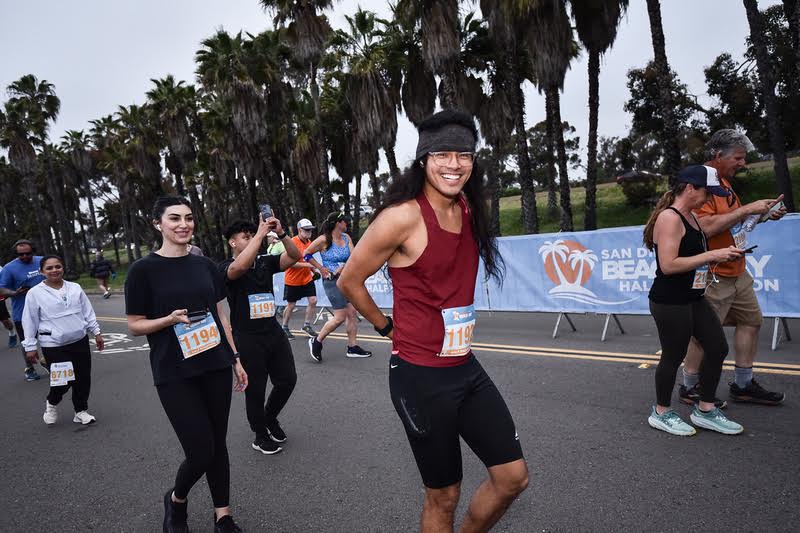
Hey y’all, it’s now Friday, April 28, and the start of race weekend for the Eugene Marathon! I landed in Eugene earlier this morning and am taking the time to get mentally settled in and give myself the best start I can for race day. There’s been a lot swirling around in my mind this past week, and I want to use the next few blog posts to capture those thoughts in writing and share them with you. (Also the writing helps me settle those thoughts and clear my mind for the race :) ). To get started, I want to reflect on last Sunday’s tune-up race: the San Diego Beach and Bay Half Marathon (SDB&B).
The Numbers, At a Glance
Distance: Half Marathon
Time: 1:40:40
Average Pace: 7:41/mi
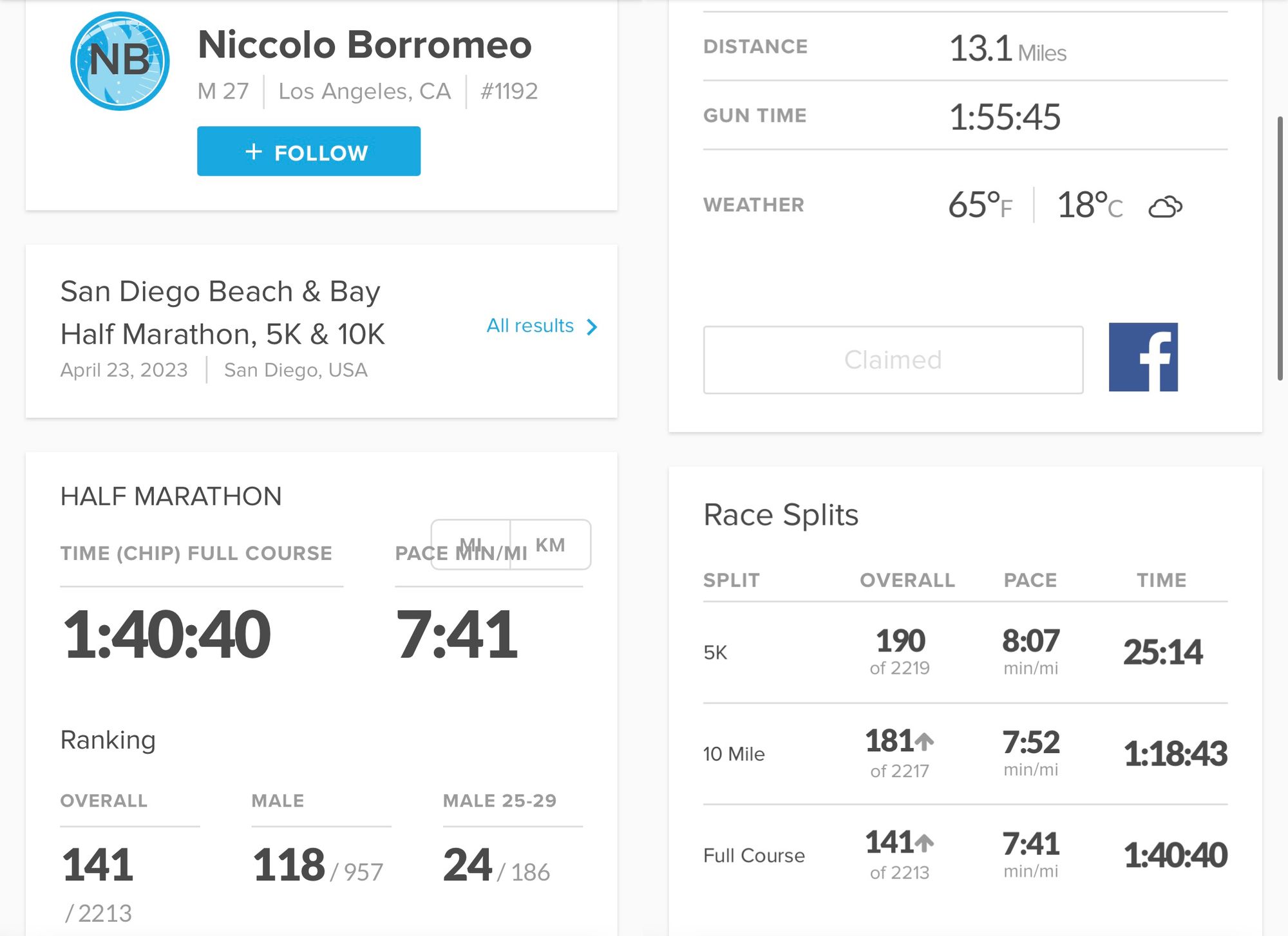
Goals
For this race I had distinct goals that were different from the goals I’d usually set for a race. Normally, you’d expect to run a race at race effort. That means running at a maximal effort (appropriate for the race, of course) and, hopefully, achieving a personal record, or PR. Since I’ve devoted this training block to the Eugene Marathon, I decided to run SDB&B as a tune-up race and workout in preparation for Eugene. With the two events one week apart, I didn’t want to go all out at SDB&B and risk going into Eugene pre-fatigued. The convenient thing was that my training plan already had a 13 mile workout planned, so doing it in a race environment was an easy choice.
So why run a race if I’m not going to actually “race” it? There’s several reasons for running a race as a tune-up. You can think of a tune-up race as a kind of dress rehearsal. It’s here where you might use the tune-up race to measure current fitness, finalize any choices for race day, and so on. For this race, my goals were to:
- Experience the race environment - Running in a race adds so many factors that are difficult to simulate in your standard everyday training run. The atmosphere, the crowds cheering, the extra pressure or jitters from hoping to get a good result, aid stations, running alongside (and hopefully passing) other runners. All of this makes racing really exciting! And oftentimes, that excitement can affect how you run. For me, I can easily get caught up in the excitement, and I’ll find myself running faster than intended. This risks burnout early in the race, and energy conservation is immensely important in achieving a strong performance all the way through the finish line. I also remember at my last marathon, CIM 2022, I found myself irritated at how many other runners there were! Duh, of course there’s other runners, but psychologically I just wasn’t used to running with so many people since I do almost all of my training runs alone. That irritated reaction caught me off guard during the race, and it distracted me from just focusing on running the race. Tune-ups are good for practicing being in that race environment and feeling out all of the odd things that can happen during a race so that they don’t come as a surprise on your actual race day.
- Test out my race kit - The “dress” part of dress rehearsal. How are my shoes fitting and feeling? Will this singlet and shorts combo be appropriate for the weather on race day? Do my shorts allow easy organization and access to my gels while running at pace? Any chafe spots? These are some of the questions I aim to answer when testing out my race kit. It’s well understood that you shouldn’t try anything new on race day, so the tune-up race is a perfect opportunity to dial in and practice all those clothing and accessory choices.
- Practice hydration and nutrition strategies - In the marathon, it’s imperative to eat and drink during the race to make it to the finish line without “hitting the wall”, or “bonking”. Throughout a training cycle, you should practice consuming gels and water or some electrolyte drink to figure out what works for your body and what doesn’t. You don’t want to risk gastrointestinal distress or cramps during your race! Similar to the race kit testing above, tune-up races give that real-life test case to see how your fueling plan works in the context of a race with all the factors and stressors that come with it.
- Run through pre-race routines - By this I’m referring to the things I do the night before the race and the morning of to prep my mind and body for the race. Pictured below is the checklist I made at the hotel of the things I wanted to make sure I did for SDB&B.
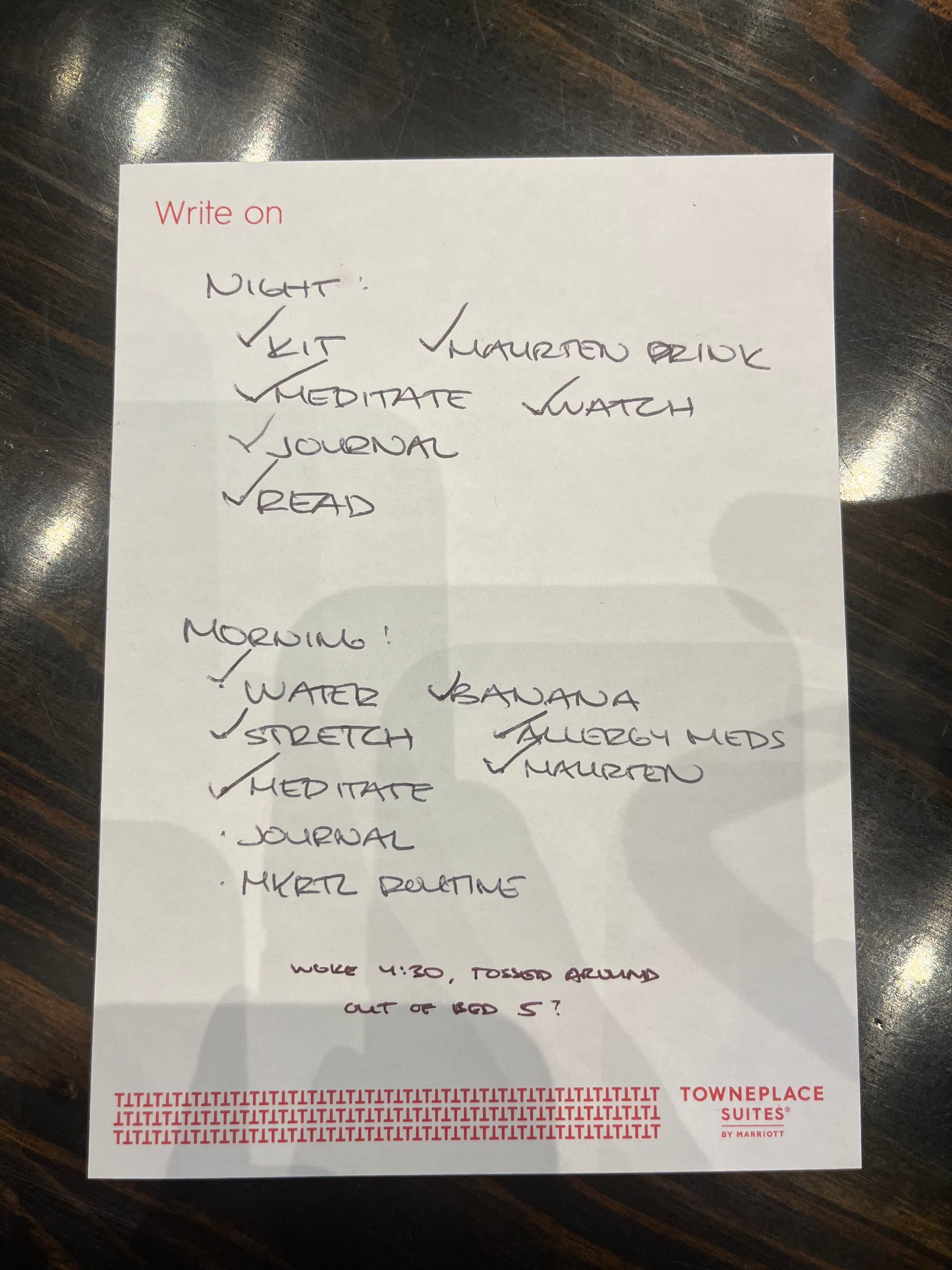
The Race & The Workout
The SDB&B Half Marathon course consists of a loop around Mission Bay in San Diego. It’s a smaller race than I’m used to, with 2,213 participants in the half marathon. For reference, the Las Vegas Rock n Roll Half Marathon I ran in February had 12,115 participants for the half. The difference seems typical of a smaller, local race versus a big city race. Weather was around 65° F, which was mild. I’m used to running races in the high 40s to 50s.
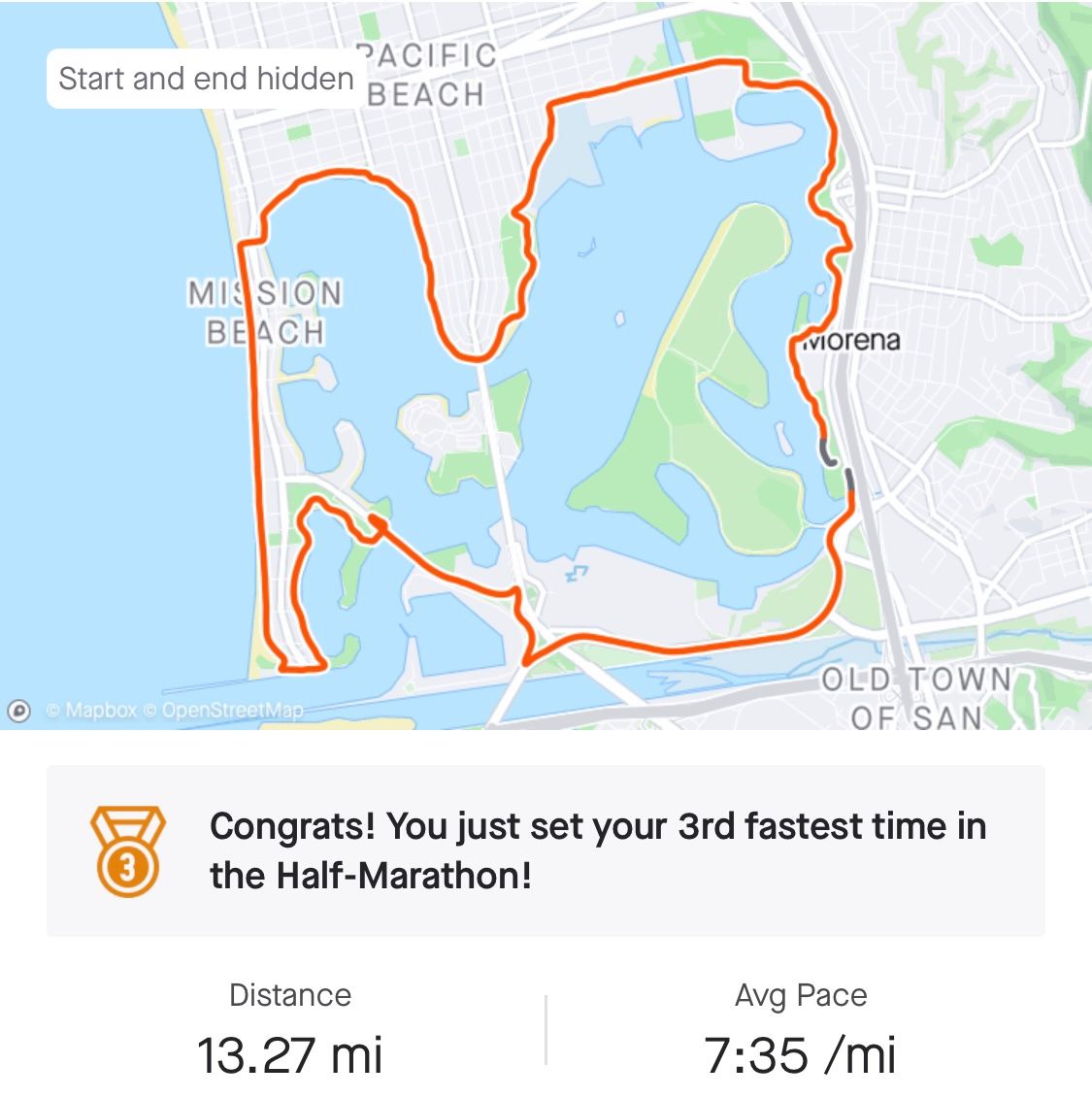
The course also had some features that I wasn’t used to, with a couple pinch points and stretches where the path was only as wide as a sidewalk. That made passing pace groups difficult. There were a handful of times where I opted to run on the sand to pass a group that occupied the width of the paved path, or I’d thread myself through gaps I could find in between runners that were tightly packed. Overall a decent course and no major complaints! It’s generally good practice to scope out a race course in advance so that you know what you’re headed into on race day, but I wanted to leave that to mystery and see how I’d deal with those surprises real-time.
The workout I had in my plan was a 13 mi interval (3 mi, 2 mi, 1 mi cut down) workout:
- 2 miles warm up (easy ish effort)
- 3 mi at Marathon pace (target 7:40)
- 2 mi easy
- 2 mi @ Half Marathon pace (7:19)
- 1 mi easy
- 1 mi @ 10k pace (7:01)
- 2 mi cooldown
You can see average paces for those segments below-left and mile-by-mile splits below-right.
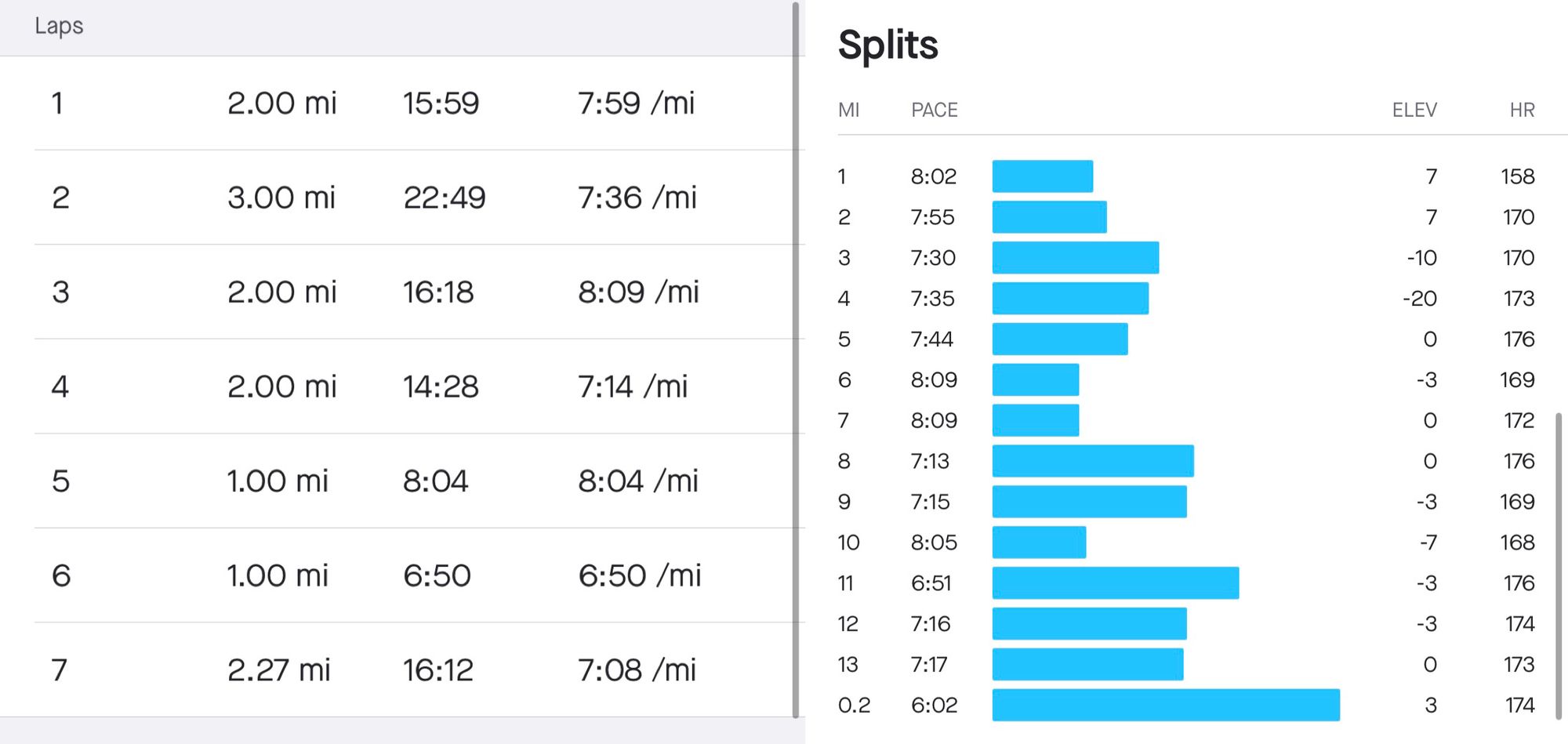
Overall I stayed pretty faithful to the workout and the target paces, just going a few seconds faster than intended. I try to manage pace by effort (how I’m feeling) and checking against what my watch is measuring, and I did catch myself going a bit fast often. What’s not shown in the pics above are the pinch points I mentioned earlier, where I had to slow down to maneuver through a crowd and pass other runners. I took a gel every three miles, which I’ve been doing in practice, and all went good there. In the last two miles I was feeling really jazzed up about racing and ended up holding half marathon effort approaching the finish line with a really solid kick at the end! Strava says this was my 3rd fastest half marathon, which is nice! But ultimately I’m not reading too much into that fact since my main intent was to do my workout as planned.
But yeah, overall walking away from this run very pleased and confident for Eugene! I got what I was wanted out of it, and that’s the most I can ask for :)

Member discussion